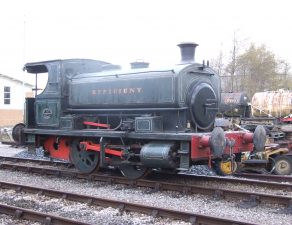
Delivered new to the Liverpool Corporation in 1928, the loco was later transferred to Lancaster Power Station in 1966, until moving to it’s final place of work, Heysham Power station in 1971. The availability of high pressure steam meant that the fireless locomotive was a very efficient method of traction.
The locomotive spent a number of years on display at Southport after being delivered on long term loan in 1993, before moving with the collection to Riversway, arriving on 1st April 1999.
The loco completed a full cosmetic restoration in 2006, and is currently exhibited in the museum building. Heysham No.2 is similar to the locomotive “Duke” – which used to work at Preston Docks.

The power station sidings in Lancaster were on either side of the Lancaster Canal embankment and connected via a line under an aqueduct. Barclay 0-4-0F 1950/1928 ‘Bluebottle’ worked here (together with Barclay 0-6-0F Lancaster 1572/1917) from 1966 until closure in 1981 and then shunted flask wagons at Heysham nuclear power station until replaced by a battery electric locomotive.
John Rennie’s Lune Aqueduct carries the Lancaster Canal across the River Lune on five arches, each spanning 70′ and at least 50′ above the river. This significant engineering achievement cost £48,000 in 1797, almost three times its original estimate, and is still open for canal traffic having outlived the railway.
Although the Lune Aqueduct of the Lancaster Canal was built more than 40 years before the railway one of its five arches was able to accommodate the double track Wennington line. Later, Lancaster Power Station was built there and a third line under the arch served coal sidings operated by fireless locomotives until closure in 1981.










